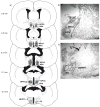The role of the medial preoptic area in appetitive and consummatory reproductive behaviors depends on sexual experience and odor volatility in male Syrian hamsters
- PMID: 20732389
- PMCID: PMC2949507
- DOI: 10.1016/j.neuroscience.2010.08.029
The role of the medial preoptic area in appetitive and consummatory reproductive behaviors depends on sexual experience and odor volatility in male Syrian hamsters
Abstract
In Syrian hamsters (Mesocricetus auratus), the expression of reproductive behavior requires the perception and discrimination of sexual odors. The behavioral response to these odors is mediated by a network of ventral forebrain nuclei, including the medial preoptic area (MPOA). The role of MPOA in male copulatory behavior has been well-studied, but less is known about the role of MPOA in appetitive aspects of male reproductive behavior. Furthermore, many previous studies that examined the role of MPOA in reproductive behavior have used large lesions that damaged other nuclei near MPOA or fibers of passage within MPOA, making it difficult to attribute post-lesion deficits in reproductive behavior to MPOA specifically. Thus, the current study used discrete, excitotoxic lesions of MPOA to test the role of this nucleus in opposite-sex odor preference and copulatory behavior in both sexually-naïve and sexually-experienced males. Lesions of MPOA eliminated preference for volatile, opposite-sex odors in sexually-naïve, but not sexually-experienced, males. When males were allowed to contact the sexual odors, however, preference for female odors remained intact. Surprisingly, lesions of MPOA caused severe copulatory deficits only in sexually-naïve males, suggesting previous reports of copulatory deficits following MPOA lesions in sexually-experienced males were not due to damage to MPOA itself. Together, these results demonstrate that the role of MPOA in appetitive and consummatory aspects of reproductive behavior varies with the volatility of the sexual odors and the sexual experience of the male.
Published by Elsevier Ltd.
Figures







Similar articles
-
Dissociated functional pathways for appetitive and consummatory reproductive behaviors in male Syrian hamsters.Horm Behav. 2012 Feb;61(2):204-11. doi: 10.1016/j.yhbeh.2011.12.007. Epub 2011 Dec 22. Horm Behav. 2012. PMID: 22210198 Free PMC article.
-
Lesions of the posterior bed nucleus of the stria terminalis eliminate opposite-sex odor preference and delay copulation in male Syrian hamsters: role of odor volatility and sexual experience.Eur J Neurosci. 2010 Aug;32(3):483-93. doi: 10.1111/j.1460-9568.2010.07277.x. Epub 2010 Jun 30. Eur J Neurosci. 2010. PMID: 20597978 Free PMC article.
-
The medial preoptic area is necessary for sexual odor preference, but not sexual solicitation, in female Syrian hamsters.Horm Behav. 2013 Apr;63(4):606-14. doi: 10.1016/j.yhbeh.2013.02.003. Epub 2013 Feb 12. Horm Behav. 2013. PMID: 23415835 Free PMC article.
-
Topography in the preoptic region: differential regulation of appetitive and consummatory male sexual behaviors.Front Neuroendocrinol. 2007 Oct;28(4):161-78. doi: 10.1016/j.yfrne.2007.05.003. Epub 2007 Jun 8. Front Neuroendocrinol. 2007. PMID: 17624413 Free PMC article. Review.
-
Integration of chemosensory and hormonal input in the male Syrian hamster brain.Ann N Y Acad Sci. 1998 Nov 30;855:362-72. doi: 10.1111/j.1749-6632.1998.tb10594.x. Ann N Y Acad Sci. 1998. PMID: 9929628 Review.
Cited by
-
Chemosensory and hormone information are relayed directly between the medial amygdala, posterior bed nucleus of the stria terminalis, and medial preoptic area in male Syrian hamsters.Horm Behav. 2011 Apr;59(4):536-48. doi: 10.1016/j.yhbeh.2011.02.005. Epub 2011 Feb 18. Horm Behav. 2011. PMID: 21316366 Free PMC article.
-
Wired for behaviors: from development to function of innate limbic system circuitry.Front Mol Neurosci. 2012 Apr 26;5:55. doi: 10.3389/fnmol.2012.00055. eCollection 2012. Front Mol Neurosci. 2012. PMID: 22557946 Free PMC article.
-
Chronic social stress in puberty alters appetitive male sexual behavior and neural metabolic activity.Horm Behav. 2014 Jul;66(2):220-7. doi: 10.1016/j.yhbeh.2014.05.002. Epub 2014 May 20. Horm Behav. 2014. PMID: 24852486 Free PMC article.
-
Dissociated functional pathways for appetitive and consummatory reproductive behaviors in male Syrian hamsters.Horm Behav. 2012 Feb;61(2):204-11. doi: 10.1016/j.yhbeh.2011.12.007. Epub 2011 Dec 22. Horm Behav. 2012. PMID: 22210198 Free PMC article.
-
Neuroanatomical Framework of the Metabolic Control of Reproduction.Physiol Rev. 2018 Oct 1;98(4):2349-2380. doi: 10.1152/physrev.00033.2017. Physiol Rev. 2018. PMID: 30109817 Free PMC article. Review.
References
-
- Arendash GW, Gorski RA. Effects of discrete lesions of the sexually dimorphic nucleus of the preoptic area or other medial preoptic regions on the sexual behavior of male rats. Brain Res Bull. 1983;10(1):147–54. - PubMed
-
- Balthazart J, Surlemont C. Copulatory behavior is controlled by the sexually dimorphic nucleus of the quail POA. Brain Res Bull. 1990;25(1):7–14. - PubMed
Publication types
MeSH terms
Substances
Grants and funding
LinkOut - more resources
Full Text Sources

